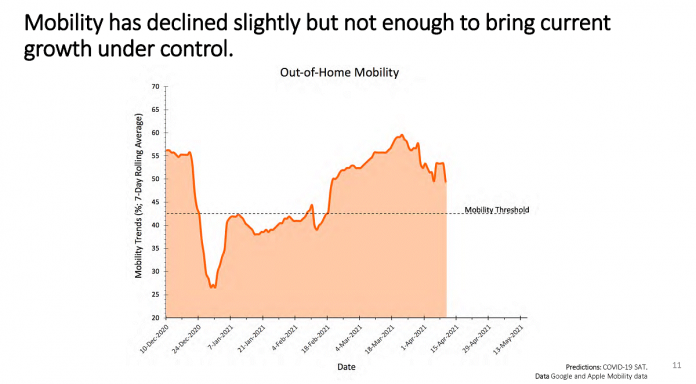
Ontario’s top science and health experts say the third wave of Ontario’s COVID-19 pandemic will persist through the summer, unless additional actions are taken immediately.
Extending Ontario’s stay-at-home order from four to six weeks, implementing and adhering to stronger public health measures, and administering at least 100,000 daily vaccine doses is the only way to flatten the curve, according to new modelling data released by the Ontario government on Friday (April 16).
Doing so will keep the number of daily cases in Ontario under 5,000 by May. Otherwise, daily cases in Ontario could peak at 18,000 daily cases by mid-June. However, in any scenario, ICU occupancy is predicted to exceed 1,500 beds by mid-May.
“I know some of us frustrated, some of us are frightened, and some of us are just fatigued, and many I know are all three,” said Adalsteinn Brown, co-chair of the Ontario COVID-19 Science Advisory Table who presented the modelling at a media briefing along with Dr. David Williams, Ontario’s chief medical officer of health.
COVID-19 cases, hospitalizations, and ICU occupancy are all at their highest levels since last March, according to the presentation, and cases of variants of concern continue to rise sharply. ICU occupancy is compromising care for all patients.
“After a year of fighting this together, we are now entering the hardest stage,” Brown said. “Cases have risen, hospitals have filled up, and across Ontario it is very clear we are very much in the third wave of COVID-19 — and the numbers are still rising. But the biggest problem we now face may be that we’re just too tired to notice.”
“So I’m begging you to notice. Notice that our hospitals can no longer function normally. They’re bursting at their seams, we’re setting up field hospitals, and we’re separating critically ill patients from their families by helicoptering them across the province for care. Our children’s hospitals are now admitting adults as patients, and this has never happened in Ontario before — it’s never happened in Canada before.”
“Notice what is happening with vaccinations … please notice when it’s your turn, and please get vaccinated — the vaccine protects you and it protects the people around you. The faster we get the third wave tamped down, the faster we open up.”
Brown urged Ontarians to limit their mobility by only leaving home for necessary trips, by always wearing a mask, and by keeping two metres of distance when in contact with anyone outside their household.
“Notice when your friends, your neighbours, your children, or even your parents meet each other without masks. Notice if your workplace is open but it shouldn’t be. Notice if your workplace isn’t safe. Notice the behaviours that we all know will put people in hospitals — in the same hospitals where we don’t have enough nurses, respiratory therapists, or doctors to treat the patients. Notice that stuff and say something. It’s uncomfortable but it will save lives.”

So far, according to Brown, Ontario’s stay-at-home order has not had the expected impact on case numbers, largely because out-of-home mobility has not declined sufficiently to prevent the variants of concern from spreading.
Although vaccination efforts are improving, Brown said, vaccines are not reaching people at high risk quickly enough to overcome the level of serious illness. Ontario could flatten the curve ever more if it could expand vaccinations to 300,000 per day, with vaccines targeted to the highest-risk communities.
Stronger public health measures could include closing all non-essential businesses, ensuring enforcement of workplace safety, and limiting mobility within and between communities.
Ontario Premier Doug Ford is expected to make an announcement of additional public health measures at 4 p.m. on Friday afternoon.
PDF: Update on COVID-19 Projections – April 16, 2021
Update on COVID-19 Projections - Ontario's Science Advisory and Modelling Consensus Tables - April 16, 2021
A copy of this PDF is available from covid19-sciencetable.ca.


























